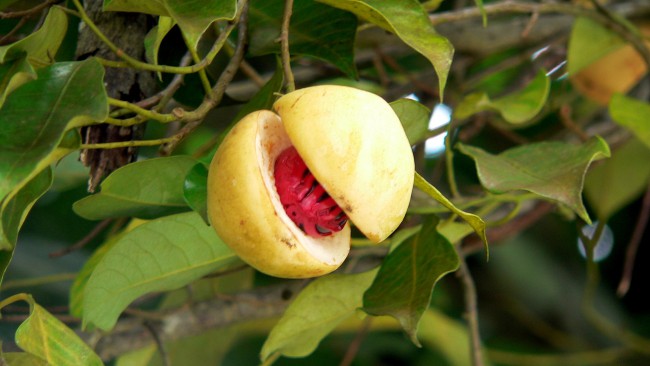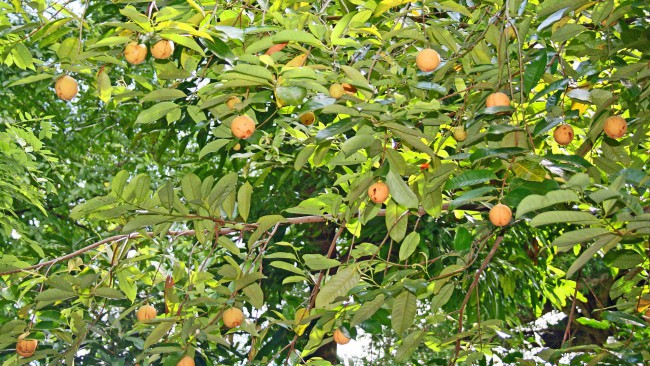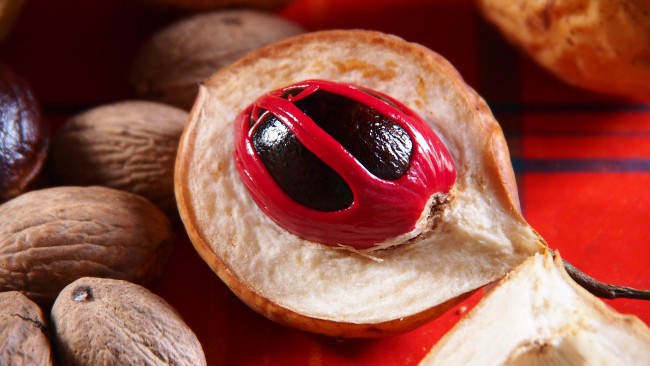
Having a pleasant scent of nutmeg is prepared actually from the kernels of the fruits growing in tropical countries of the nutmeg tree (musotica). Nutmeg is similar to cinnamon discussed earlier, one of the most highly valued spices because it is fragrant, is an aphrodisiac and has healing properties. It has its origin from the rain forests of the Moluccas (Indonesia). Botanists refer it to the family Myristicaceae, its scientific name is Myristica fragrans.

In the tropics there are also other members of the family Myristica — M. argentea, M. malabarica (India) and M. fatua. They have properties similar to M. fragrans, although the aroma and taste of spices are less saturated. On the resource Nutrition And You a lot of interesting things written about the beneficial properties of nutmeg. Despite the many useful properties of nutmeg to use it very sparingly and if there is even the slightest doubt consult with the doctor, rather than relying on received information from the Internet.
The evergreen nutmeg tree is large and can reach 20 meters in height. The fruit of the nutmeg tree size is similar to apricot. In the middle of the fruit is a solid core, which prepares popular spice. This bone has a crimson red coating. It is called “nutmeg”.
A nutmeg tree can bear fruit up to three times a year. Directly under the husk on the kernel is Golden-brown prisemyannik. It is removed from the kernel line, forming “ribbons”, are dried and sold in that form or in the form of powder. The kernel of nutmeg is then dried for several days or even weeks under sunlight. To accelerate the drying process using special machines.
And “nuts” is placed in the calcium hydroxide to avoid the entry of insects and nucleation.
Thus, from nutmeg get two spices from its prisemyannika and the bone.
Use nutmeg for health

Spices of nutmeg contain many chemical compounds of plant origin that are known for their antioxidant properties, ability to prevent disease and improve health.
In walnut nutmeg contains volatile oil trimyristin (myristin, trimyristin of glycerol), as well as many essential volatile oils that give nutmeg nut its sweet flavor. Among these oils include myristicin, elemicin, eugenol and safrole. Other volatile oils are — pinene, turpentine, dipentene, cineole, linalool, Sabine, terpineol.
Active principles of nutmeg found numerous applications in various therapeutic methods of traditional medicines. It is used as an antifungal agent, an antidepressant, an aphrodisiac, to improve the digestive functions and as a carminative.
This spice is a good source of minerals such as copper, potassium, calcium, manganese, iron, zinc and magnesium. Potassium is an important component of cells and fluids of the body, helping to control heart heart rate and blood pressure. Manganese and copper used by the body as factors related to the antioxidant enzyme superoxide dismutase. Iron is essential for red blood cell production, as well as co-factor for enzyme cytochromoxidase.
Nutmeg is also rich in vitamin C and B-complex vitamins — folic acid, Riboflavin, nicotinic acid, vitamin A and flavonoid antioxidants, which include beta-carotene and cryptoxanthin that are necessary for health.
The use of nutmeg in medicine

Since ancient times, nutmeg and derived from it the oil was used in Chinese and Indian traditional medicines for the treatment of diseases of the nervous and digestive systems. Contained in this spice compounds such as myristicin and elemicin are sedatives and do have on the brain stimulating effect.
Oil of nutmeg contains eugenol, used in dentistry to relieve toothache.
The oil of nutmeg is also used for local massage to reduce muscular pain and rheumatic pain in the ligaments.
Freshly prepared decoction with honey has been used to relieve nausea, gastritis and indigestion.
Caution

Eating nutmeg in large quantities can cause lack of concentration, sweating, palpitations, body pain and in some cases even hallucinations and delusions. Pregnant and lactating nutmeg may be used only in very small amounts, notes resource Nutrition And You.
Nutritional value of nutmeg

Numbers in parentheses are the percentage of daily intake. Nutritional values are per 100 grams ground nutmeg according to information from the Ministry of agriculture of the USA, please see pages resource Nutrition And You.
General information:
energy value 525 kcal (26%);
carbohydrates — 49,29 grams (38%);
protein — 5,84 g (10%);
fat — 36,31 grams (180 %);
fiber, part of the food — 20.8 grams (55%).
Vitamins:
folic acid (vitamin B9) — 76 micrograms (19%);
nicotinic acid (vitamin B3) — 1,299 milligrams (8%);
pyridoxine (vitamin B6) — 0,160 mg (12%);
Riboflavin (vitamin B2) — to 0.057 milligrams (4%);
thiamin (vitamin B1) — 0,346 milligrams (29%);
vitamin A, which lot is contained in dandelion — 102 international units (IU, IU) and 3.5%;
vitamin C — 3 mg (5%).
Electrolytes:
sodium 16 mg (1%);
potassium — 350 milligrams (from 7.5%).
Minerals:
calcium — 184 milligrams (18%);
copper — 1,027 milligrams (114%);
iron — 3.04 milligrams (38%);
magnesium 183 mg (46%);
manganese — 2,900 milligrams (126%);
phosphorus is 213 milligrams (30%);
zinc — 2.15 milligrams (20%).
Phytonutrients:
beta-carotene (ß-carotene), which is rich in carrots — 16 microgram;
beta-cryptoxanthin (β-cryptoxanthin) is 90 micrograms;
lutein-zeaxanthin 0 micrograms.
Did you know that nutmeg is beneficial for nervous and digestive systems of the human body?
